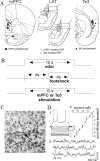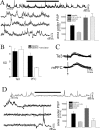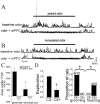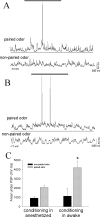The prefrontal cortex regulates lateral amygdala neuronal plasticity and responses to previously conditioned stimuli
- PMID: 14657162
- PMCID: PMC6741051
- DOI: 10.1523/JNEUROSCI.23-35-11054.2003
The prefrontal cortex regulates lateral amygdala neuronal plasticity and responses to previously conditioned stimuli
Abstract
The amygdala plays a role in learning and memory processes that involve an emotional component. However, neural structures that regulate these amygdala-dependent processes are unknown. Previous studies indicate that regulation of affect may be imposed by the prefrontal cortex (PFC) and its efferents to the amygdala. The presentation of conditioned affective stimuli enhances activity of neurons in the lateral nucleus of the amygdala (LAT), which is thought to drive conditioned affective responses. Moreover, plasticity of LAT neuronal responses to stimuli during the course of conditioning is believed to underlie affective learning. This study examines the role of the PFC in the regulation of affective behaviors by evaluating how the PFC affects LAT neuronal plasticity and activity that is evoked by previously conditioned stimuli. In vivo intracellular recordings were performed from the LAT of anesthetized rats during pavlovian conditioning and during the presentation of stimuli that were conditioned in the awake rat before recording. Train stimulation of the PFC suppressed LAT neuronal activity that was evoked by both previously conditioned and neutral stimuli. In addition, PFC stimulation blocked LAT neuronal plasticity associated with an affective conditioning procedure. These results indicate that the PFC has the potential to regulate affective processes by inhibition of the LAT. Patients with disruptions of the PFC-LAT interaction often display an inability to regulate affective responses. This may be attributable to the loss of PFC-imposed inhibition of the emotional response to a stimulus but may also include the formation or diminished extinction of inappropriate associations.
Figures







Similar articles
-
Dopamine-mediated modulation of odour-evoked amygdala potentials during pavlovian conditioning.Nature. 2002 May 16;417(6886):282-7. doi: 10.1038/417282a. Nature. 2002. PMID: 12015602
-
Regulation of conditioned responses of basolateral amygdala neurons.Physiol Behav. 2002 Dec;77(4-5):489-93. doi: 10.1016/s0031-9384(02)00909-5. Physiol Behav. 2002. PMID: 12526988 Review.
-
Cellular mechanisms of infralimbic and prelimbic prefrontal cortical inhibition and dopaminergic modulation of basolateral amygdala neurons in vivo.J Neurosci. 2002 Jan 1;22(1):324-37. doi: 10.1523/JNEUROSCI.22-01-00324.2002. J Neurosci. 2002. PMID: 11756516 Free PMC article.
-
Neuronal responses of the rat amygdala during extinction and reassociation learning in elementary and configural associative tasks.Eur J Neurosci. 2002 Feb;15(4):753-68. doi: 10.1046/j.1460-9568.2002.01889.x. Eur J Neurosci. 2002. PMID: 11886454
-
[Neural mechanisms of intelligence, emotion, and intention].Brain Nerve. 2008 Sep;60(9):995-1007. Brain Nerve. 2008. PMID: 18807934 Review. Japanese.
Cited by
-
Controllability modulates the anticipatory response in the human ventromedial prefrontal cortex.Front Psychol. 2012 Dec 14;3:557. doi: 10.3389/fpsyg.2012.00557. eCollection 2012. Front Psychol. 2012. PMID: 23550176 Free PMC article.
-
Dysregulation of the dopamine system in the pathophysiology of schizophrenia and depression.Nat Rev Neurosci. 2016 Aug;17(8):524-32. doi: 10.1038/nrn.2016.57. Epub 2016 Jun 3. Nat Rev Neurosci. 2016. PMID: 27256556 Free PMC article. Review.
-
Neurobiological mechanisms underlying the blocking effect in aversive learning.J Neurosci. 2012 Sep 19;32(38):13164-76. doi: 10.1523/JNEUROSCI.1210-12.2012. J Neurosci. 2012. PMID: 22993433 Free PMC article.
-
The default-mode, ego-functions and free-energy: a neurobiological account of Freudian ideas.Brain. 2010 Apr;133(Pt 4):1265-83. doi: 10.1093/brain/awq010. Epub 2010 Feb 28. Brain. 2010. PMID: 20194141 Free PMC article. Review.
-
A subpopulation of neurons in the medial prefrontal cortex encodes emotional learning with burst and frequency codes through a dopamine D4 receptor-dependent basolateral amygdala input.J Neurosci. 2005 Jun 29;25(26):6066-75. doi: 10.1523/JNEUROSCI.1168-05.2005. J Neurosci. 2005. PMID: 15987936 Free PMC article.
References
-
- al Maskati HA, Zbrozyna AW ( 1989) Stimulation in prefrontal cortex area inhibits cardiovascular and motor components of the defense reaction in rats. J Auton Nerv Syst 28: 117-125. - PubMed
-
- Ananth H, Popescu I, Critchley HD, Good CD, Frackowiak RS, Dolan RJ ( 2002) Cortical and subcortical gray matter abnormalities in schizophrenia determined through structural magnetic resonance imaging with optimized volumetric voxel-based morphometry. Am J Psychiatry 159: 1497-1505. - PubMed
-
- Anderson SW, Damasio H, Tranel D, Damasio AR ( 2000) Long-term sequelae of prefrontal cortex damage acquired in early childhood. Dev Neuropsychol 18: 281-296. - PubMed
Publication types
MeSH terms
Grants and funding
LinkOut - more resources
Full Text Sources
Other Literature Sources
Research Materials
Miscellaneous
